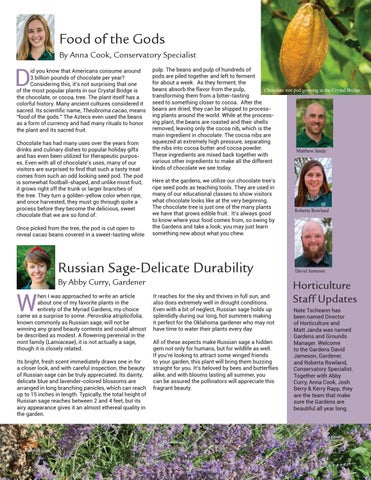Food of the Gods By Anna Cook, Conservatory Specialist
D
id you know that Americans consume around 3 billion pounds of chocolate per year? Considering this, it’s not surprising that one of the most popular plants in our Crystal Bridge is the chocolate, or cocoa, tree. The plant itself has a colorful history. Many ancient cultures considered it sacred. Its scientific name, Theobroma cacao, means “food of the gods.” The Aztecs even used the beans as a form of currency and had many rituals to honor the plant and its sacred fruit. Chocolate has had many uses over the years from drinks and culinary dishes to popular holiday gifts and has even been utilized for therapeutic purposes. Even with all of chocolate’s uses, many of our visitors are surprised to find that such a tasty treat comes from such an odd looking seed pod. The pod is somewhat football-shaped, and unlike most fruit, it grows right off the trunk or larger branches of the tree. They turn a golden-yellow color when ripe, and once harvested, they must go through quite a process before they become the delicious, sweet chocolate that we are so fond of. Once picked from the tree, the pod is cut open to reveal cacao beans covered in a sweet-tasting white
pulp. The beans and pulp of hundreds of pods are piled together and left to ferment for about a week. As they ferment, the beans absorb the flavor from the pulp, Chocolate tree pod growing in the Crystal Bridge transforming them from a bitter-tasting seed to something closer to cocoa. After the beans are dried, they can be shipped to processing plants around the world. While at the processing plant, the beans are roasted and their shells removed, leaving only the cocoa nib, which is the main ingredient in chocolate. The cocoa nibs are squeezed at extremely high pressure, separating the nibs into cocoa butter and cocoa powder. Matthew Janda These ingredients are mixed back together with various other ingredients to make all the different kinds of chocolate we see today. Here at the gardens, we utilize our chocolate tree’s ripe seed pods as teaching tools. They are used in many of our educational classes to show visitors what chocolate looks like at the very beginning. The chocolate tree is just one of the many plants we have that grows edible fruit. It’s always good to know where your food comes from, so swing by the Gardens and take a look; you may just learn something new about what you chew.
Russian Sage-Delicate Durability
W
By Abby Curry, Gardener
hen I was approached to write an article about one of my favorite plants in the entirety of the Myriad Gardens, my choice came as a surprise to some. Perovskia atriplicifolia, known commonly as Russian sage, will not be winning any grand beauty contests and could almost be described as modest. A flowering perennial in the mint family (Lamiaceae), it is not actually a sage, though it is closely related. Its bright, fresh scent immediately draws one in for a closer look, and with careful inspection, the beauty of Russian sage can be truly appreciated. Its dainty, delicate blue and lavender-colored blossoms are arranged in long branching panicles, which can reach up to 15 inches in length. Typically, the total height of Russian sage reaches between 2 and 4 feet, but its airy appearance gives it an almost ethereal quality in the garden.
Russian Sage Liatris pycnostachya, Prairie Blazing Star Photo by Carl Shortt Jr.
It reaches for the sky and thrives in full sun, and also does extremely well in drought conditions. Even with a bit of neglect, Russian sage holds up splendidly during our long, hot summers making it perfect for the Oklahoma gardener who may not have time to water their plants every day. All of these aspects make Russian sage a hidden gem not only for humans, but for wildlife as well. If you’re looking to attract some winged friends to your garden, this plant will bring them buzzing straight for you. It’s beloved by bees and butterflies alike, and with blooms lasting all summer, you can be assured the pollinators will appreciate this fragrant beauty.
Roberta Rowland
David Jameson
Horticulture Staff Updates Nate Tscheann has been named Director of Horticulture and Matt Janda was named Gardens and Grounds Manager. Welcome to the Gardens David Jameson, Gardener, and Roberta Rowland, Conservatory Specialist. Together with Abby Curry, Anna Cook, Josh Berry & Kerry Rapp, they are the team that make sure the Gardens are beautiful all year long.
7
8





